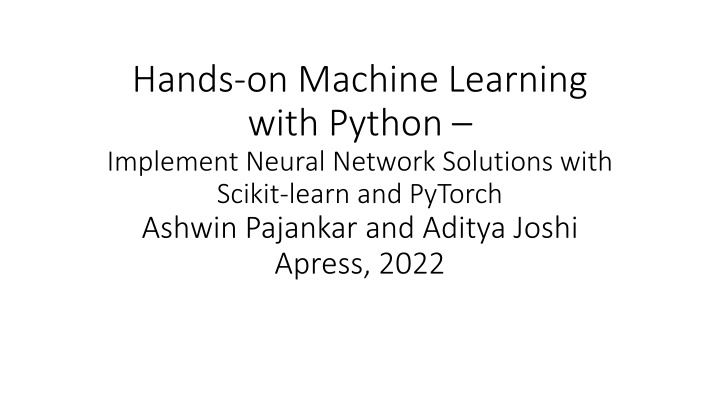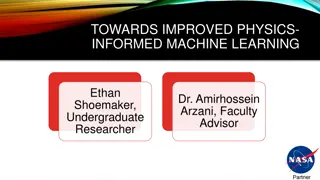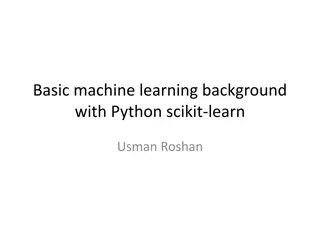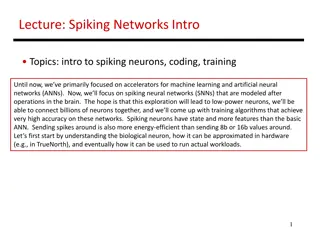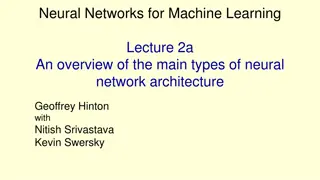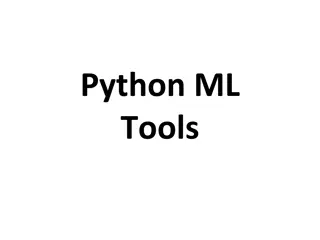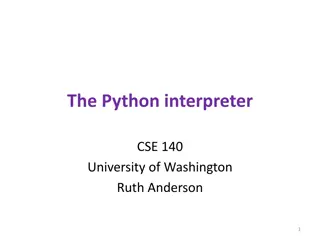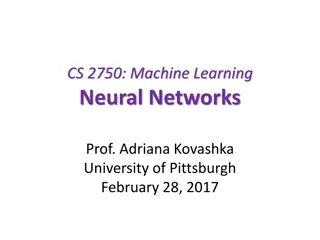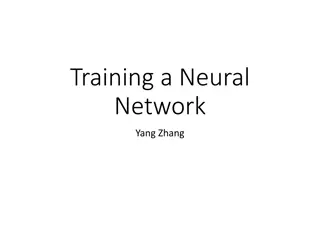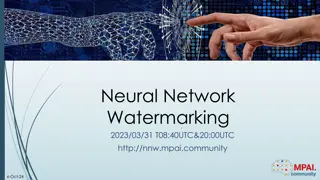Hands-on Machine Learning with Python: Implement Neural Network Solutions
Explore machine learning concepts from Python basics to advanced neural network implementations using Scikit-learn and PyTorch. This comprehensive guide provides step-by-step explanations, code examples, and practical insights for beginners in the field. Covering topics such as data visualization, NumPy, Pandas, supervised and unsupervised learning methods, and deep learning techniques, this book serves as a valuable resource for aspiring data scientists and machine learning enthusiasts.
Download Presentation

Please find below an Image/Link to download the presentation.
The content on the website is provided AS IS for your information and personal use only. It may not be sold, licensed, or shared on other websites without obtaining consent from the author.If you encounter any issues during the download, it is possible that the publisher has removed the file from their server.
You are allowed to download the files provided on this website for personal or commercial use, subject to the condition that they are used lawfully. All files are the property of their respective owners.
The content on the website is provided AS IS for your information and personal use only. It may not be sold, licensed, or shared on other websites without obtaining consent from the author.
E N D
Presentation Transcript
Hands-on Machine Learning with Python Implement Neural Network Solutions with Scikit-learn and PyTorch Ashwin Pajankar and Aditya Joshi Apress, 2022
Contents Introduction Section 1 Python for Machine Learning Chapter 1 Getting Started with Python 3 and Jupyter Notebook Chapter 2 Getting Started with NumPy Chapter 3 Introduction to Data Visualization Chapter 4 Introduction to Pandas
Section 2 Machine Learning Approaches Chapter 5 Introduction to Machine Learning with Scikit-learn Chapter 6 Preparing Data for Machine Learning Chapter 7 Supervised Learning Methods: Part 1 Chapter 8 Tuning Supervised Learners Chapter 9 Supervised Learning Methods: Part 2 Chapter 10 Ensemble Learning Methods Chapter 11 Unsupervised Learning Methods
Section 3 Neural Networks and Deep Learning Chapter 12 Neural Network and PyTorch Basics Chapter 13 Feedforward Neural Networks Chapter 14 Convolutional Neural Networks Chapter 15 Recurrent Neural Networks Chapter 16 Bringing It All Together
Introduction We realized that, as lifelong learners ourselves, the initial few steps in any field require a much clearer source that shows a path clearly. This also requires a crisp set of explanation and occasional ideas to expand the learning experience by reading, learning, and utilizing what you have learned. We have used Python for a long duration in our academic life and professional careers in software development, data science, and machine learning.
We have made a very humble attempt to write a step-by-step guide on the topic of machine learning for absolute beginners. Every chapter of the book has the explanation of the concepts used, code examples, explanation of the code examples, and screenshots of the outputs.
The first chapter covers the setup of the Python environment on different platforms. The second chapter covers NumPy and Ndarrays. The third chapter explores visualization with Matplotlib. The fourth chapter introduces us to the Pandas data science library. All these initial chapters build the programming and basic data crunching foundations that are one of the prerequisites for learning machine learning.
Section 2 discusses traditional machine learning approaches. In Chapter 5, we start with a bird s-eye view of the field of machine learning followed by the installation of Scikit-learn and a short and quick example of a machine learning solution with Scikit-learn. Chapter 6 elaborates methods to help you understand and transform structural, textual, and image data into the format that s acceptable by machine learning libraries.
In Chapter 7, we introduce supervised learning methods, starting with linear regression for regression problems and logistic regression and decision trees for classification problems. The eighth chapter ponders over further fine-tuning of machine learning models. We explain some ideas for measuring the performance of the models, issues of overfitting and underfitting, and approaches for handling such issues and improving the model performance.
The ninth chapter continues the discussion of supervised learning methods especially focusing on naive Bayes and Support Vector Machines. The tenth chapter explains ensemble learning methods, which are the solutions that combine multiple simpler models to produce a performance better than what they might offer individually. In the eleventh chapter, we discuss unsupervised learning methods, specifically focusing on dimensionality reduction, clustering, and frequent pattern mining methods.
The last section begins with introducing the basic ideas of neural network and deep learning in the twelfth chapter. We introduce a highly popular open source machine learning framework, PyTorch, that will be used in the examples in the subsequent chapters. The thirteenth chapter begins with the explanation of artificial neural networks and thoroughly discusses the theoretical foundations of feedforward and backpropagation. We explain how to create a multilayer neural network that is capable of identifying handwritten digits.
In the fourteenth chapter, we discuss convolutional neural networks and work through an example for image classification. The fifteenth chapter discusses recurrent neural networks and walks you through a sequence modeling problem. In the final, sixteenth chapter, we discuss strategies for planning, managing, and engineering machine learning and data science projects.
